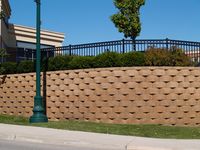What You Need to Know About Building a Retaining Wall

When building out your landscaping or constructing a home addition, the land around the site needs to be prepared. While most areas need little more than a bit of leveling out, others require additional elements to ensure the area is safe and secure against moving soil and dirt. A retaining wall is one of the most important tools landscapers use to create eye-catching gardens and designs. However, no two walls are the same and the height of them can have various effects.
What Does a Retaining Wall Do?
 A retaining wall holds back large mounds of dirt and soil to make a low-lying space secure enough to build a garden or structure. Since they keep the dirt in place, the walls also prevent erosion, help direct drainage and runoff from storms, and increase the amount of usable space in otherwise tight yards. The actual parameters of the wall will differ based on the type of load the wall needs to support and the purpose of the wall itself. Some homeowners incorporate retaining structures for aesthetic reasons while others use them for strictly utilitarian purposes.
A retaining wall holds back large mounds of dirt and soil to make a low-lying space secure enough to build a garden or structure. Since they keep the dirt in place, the walls also prevent erosion, help direct drainage and runoff from storms, and increase the amount of usable space in otherwise tight yards. The actual parameters of the wall will differ based on the type of load the wall needs to support and the purpose of the wall itself. Some homeowners incorporate retaining structures for aesthetic reasons while others use them for strictly utilitarian purposes.
How Tall Can They Be?
These walls can vary in height from as small as 2 feet to well over 20. The only limitation is the amount of space the yard has. The taller the wall, the stronger the foundation needs to be and the thicker the system becomes. Most homeowners only need walls ranging from 2-foot garden boundaries to 5-foot tall systems to keep dirt from falling into a flower or vegetable bed. Your landscaping contractor will determine the best wall for your yard. Remember, installing a taller structure is not always better. It requires more materials and labor, resulting in higher costs.
Looking for a reliable contractor to build or repair your yard’s retaining wall? Contact Emerald Coast Landscaping in Orange Beach, AL. For more than 16 years, their experienced residential landscaping team has helped homeowners breathe new life into their yards. Learn more about their services by visiting their website and call (251) 269-8128 to schedule an on-site estimate.
About the Business
(4 reviews)
Have a question? Ask the experts!
Send your question

